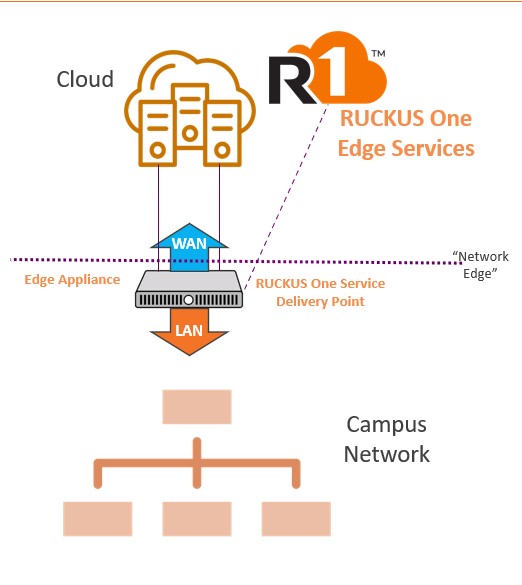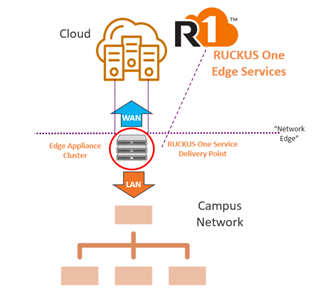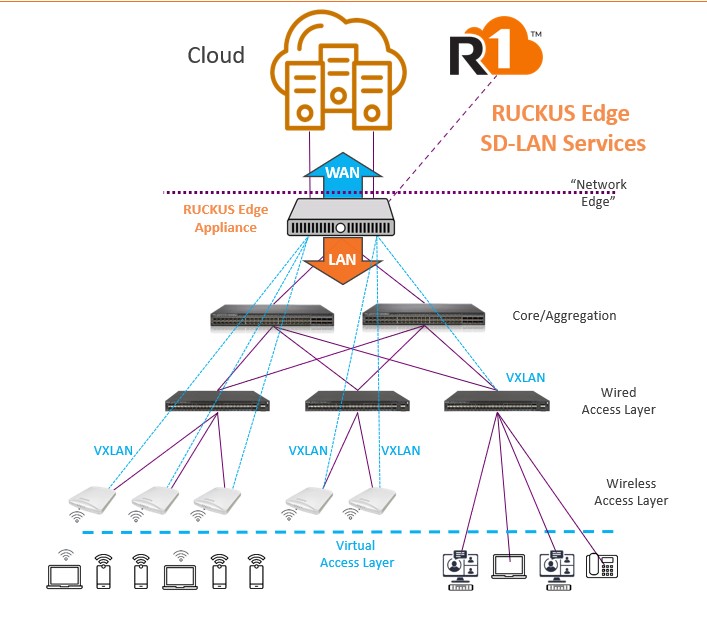Willkommen bei RUCKUS Networks, einem Teil des weltweit führenden Portfolios an Netzwerklösungen von CommScope. Mehr erfahren.
The demand for high performance, always on, network connectivity, that is easy to deploy and manage has skyrocketed. Whether it's providing seamless streaming services across the campus in multi-dwelling units (MDUs), enabling real-time guest services in hospitality, or for consistent access to cloud-based learning tools in educational institutions, the pressure is on to deliver high-quality, low-latency network experiences.
While cloud-based applications are powerful, effortless to deploy, and accessible from anywhere, they can sometimes fail to meet the split-second response time expectations of today's tech-savvy users. The RUCKUS Edge service delivery platform is designed to extend the capabilities of the AI driven, cloud-based RUCKUS One® platform to the network edge, delivering faster performance, greater security, and simplified management.
What is RUCKUS Edge?
At its core, the RUCKUS Edge Services Delivery Platform brings the power of the RUCKUS One cloud platform to the edge of the network. By doing so, it transforms how services are deployed and managed, enabling organizations to deliver high-performance, low-latency experiences right where they're needed most—whether that’s in a university campus, a hotel room, or an apartment complex.
Figure 1: RUCKUS Edge appliance orchestrated by RUCKUS One cloud-based platform
Why did we build RUCKUS Edge?
The massive adoption of cloud-based applications in industries like hospitality, education, and MDUs has created new challenges. These include increased latency, data privacy concerns, and security risks. Traditional, centralized cloud models often struggle to meet the high-performance demands of these verticals, resulting in degraded service quality and increased vulnerability.
The RUCKUS Edge platform directly addresses these challenges by bringing service delivery to the edge of the network, closer to the user. By processing data locally, RUCKUS Edge reduces latency and strengthens security, resulting in a smoother, more responsive user experience.
In hospitality, for example, guests now expect real-time, personalized services, from booking to in-room experiences powered by IoT devices. Edge computing enables hotels to deliver these services quickly and efficiently, without the delays associated with centralized cloud models. Similarly, in MDUs, residents increasingly expect fast, reliable access to smart home applications, entertainment services, and high-speed internet—RUCKUS Edge delivers on these expectations, keeping residents satisfied and engaged.
Key Features of RUCKUS Edge
The RUCKUS Edge platform is built to solve the growing challenges of network performance, security, and management in distributed cloud-based environments. The integration of the RUCKUS One service catalog as a centralized hub for deploying RUCKUS Edge diverse array of services positions RUCKUS as a key player in the evolving landscape of hybrid enterprise . Here’s a look at the key features that make the RUCKUS Edge platform a must have for organizations in sectors like hospitality, MDUs, education, and beyond.
- Hybrid Cloud Management via RUCKUS One
RUCKUS Edge is integrated with RUCKUS One, an AI Driven, hybrid cloud platform that centralizes network management across wired, wireless, and IoT networks. This means that network administrators, whether managing MDUs, campuses, or hotels, can control their entire network infrastructure from a single, intuitive interface. RUCKUS One streamlines everything from network configuration to monitoring and troubleshooting, reducing the need for on-site management. For large, geographically dispersed properties, this is a massive time-saver and helps to reduce operational complexity.
With RUCKUS One, managing multiple network types becomes simple. You no longer need to manage separate systems for wired, wireless, and IoT environments. The platform provides a unified, holistic view of the entire network, making it easier to validate that every aspect of the infrastructure is running optimally.
- Local Breakout with Edge appliance
The RUCKUS Edge appliance acts as the local service delivery point, handling traffic forwarding and breakout locally. For environments that experience high bandwidth usage, such as MDUs, college campuses, or hotels, this is crucial. Rather than backhauling traffic to the cloud, the edge appliance processes it locally, significantly reducing latency. This means faster response times for bandwidth-intensive applications like streaming, gaming, or real-time collaboration tools.
In MDUs, for example, residents increasingly demand fast, reliable access to smart home applications and entertainment services. The RUCKUS Edge platform enables them to stream movies, play online games, or use their voice assistants wherever they are in the property without experiencing lag or service interruptions. Similarly, in educational institutions, students and faculty can access cloud-based learning platforms across the campus without the frustration of long loading times or dropped connections.
- Advanced Security and Privacy with VXLAN Based SD-LAN Tunneling
Security is a top priority in today’s connected world, and the RUCKUS Edge platform is designed to ensure that users have secure, isolated access to network resources. This is achieved through VXLAN (Virtual Extensible LAN) tunneling, which creates virtual Layer 2 networks over a Layer 3 infrastructure. In practice, this allows for network segmentation, enabling different user groups—whether they’re tenants in an apartment complex, students on a university campus, or guests at a hotel—to have secure, isolated access to the network.
This level of security and privacy is especially important in environments where multiple groups of users require access to shared network infrastructure. For example, on a university campus, students, staff, visitors, and contractors all need network access, but it’s critical that their data remain private and secure. VXLAN enables each group to operate within its own secure virtual network, protecting data privacy and improving overall security.
- Seamless Wi-Fi® Roaming for Continuous Connectivity with SD-LAN
One of the key challenges in large, distributed environments like MDUs or educational campuses is maintaining a seamless connection as users move from one area to another. The RUCKUS Edge platform enables seamless Wi-Fi roaming across an entire site without interrupting user connections, preserving connected devices’ IP addresses while users roam from one Wi-Fi access point (AP) to the next. This is particularly beneficial in environments where mobile connectivity is critical, such as for students moving between lecture halls, or tenants navigating a large residential complex.
For example, tenants in MDUs can walk around their buildings with their devices, streaming music, making video calls, or controlling smart home devices, without ever losing their connection. The ability to roam seamlessly across the network improves the overall user experience and reduces the frustration caused by dropped connections.
- AI-Driven Analytics, Automation and Assurance
Network management can be complex, but the RUCKUS Edge platform makes it easier by leveraging AI-powered insights for network analytics, performance optimization, and automated issue detection and AI-driven resolution. This proactive approach means that potential network issues, such as bandwidth bottlenecks or overloaded access points, can be detected and resolved before they affect users.
The AI engine embedded in the RUCKUS One platform delivers robust service assurance for IT and business intelligence to line-of-business stakeholders to help get the most from enterprise networks. Powered by artificial intelligence (AI) and machine learning (ML) algorithms, this cloud service simplifies life by automatically classifying service incidents by severity—tracing root causes and recommending steps for remediation.
For environments like MDU, hotels, or universities where uninterrupted connectivity is critical, this level of automation helps prevent downtime and delivers always on access the services they need. AI-driven automation also reduces the burden on IT staff by automating routine tasks such as firmware updates, network optimization, and troubleshooting, freeing up valuable time and resources.
- Personal Identity Networks for a Personalized Experience via SD-LAN
In environments like student housing or MDUs, where residents have multiple connected devices—smart TVs, gaming consoles, Wi-Fi speakers, etc.—the ability to personalize their network experience is key. RUCKUS Edge offers Personal Identity Networks* (PINs), allowing users to have their own personalized network segment that travels with them throughout the property.
With a PIN, tenants or students can manage their devices as if they had their own private network, even when connected to shared infrastructure. This enhances the user experience by making it easier to connect and control devices while maintaining security and privacy across a shared network environment.
- Redundant Clusters for High Availability
For organizations that require high availability and network resiliency, RUCKUS Edge offers the ability to deploy edge appliances in redundant active-active clusters. This means that if one appliance fails, other appliances within the cluster seamlessly take over without service interruption. Additionally, load is distributed across appliances within a cluster to increase capacity and maintain response time under heavy load. This level of protection is crucial for mission-critical environments where any amount of downtime can have significant consequences.
Figure 2: High Availability with RUCKUS Edge Active-Active Cluster
- Pay-as-You-Go Flexibility and Scalability
One of the standout features of the RUCKUS Edge platform is its flexible, subscription-based pricing model. This allows organizations to pay only for the services they use, reducing total cost of ownership (TCO) while maintaining the flexibility to scale as needed. Whether you’re managing a small residential complex or a large, multi-building campus, RUCKUS Edge can scale with your needs.
- Flexible Deployment Options
RUCKUS Edge can be deployed as virtual or physical appliances to meet the needs of organizations of all types and sizes
Physical appliances: Plug and play RUCKUS Edge appliances are well suited for organizations that have “lean IT” departments with limited virtualization expertise or those that wish to further simplify deployments in tenant locations.
Virtual appliances: RUCKUS Edge virtual appliances are targeted at organizations with specialized IT teams that have expertise in deploying a virtualized infrastructure across central and on-site locations.
SD-LAN: A RUCKUS Edge Service That Redefines Network Flexibility
As organizations move through their digital transformation, the demands on the network infrastructure rapidly evolves. Traditional network architectures struggle to keep pace with the dynamic requirements of modern environments like multi-dwelling units (MDUs), university campuses, enterprises, and hospitality venues. Enter SD-LAN (Software-Defined LAN), a powerful Edge service from RUCKUS, managed from the cloud that revolutionizes the way networks are designed, deployed, and managed.
SD-LAN brings advanced network virtualization and automation directly to the network edge. This next-gen networking solution offers organizations a new level of flexibility, allowing them to easily create and manage custom virtual overlay networks to meet the specific needs of different applications, users, or device types—all while simplifying network operations through centralized cloud management.
Figure 3: SD-LAN Edge Services Enable LAN Virtualization
Key Features of RUCKUS® SD-LAN
- Seamless SD-LAN Overlay Networks
One of the most compelling features of SD-LAN is its ability to create seamless overlay networks on demand. These virtual networks, which can be configured in just a few clicks via the RUCKUS One interface, provide fine-grained control over network traffic, segmentation, and security. Each overlay can be customized to meet the unique needs of different user groups, applications, or device types. This allows organizations to offer tailored network experiences, whether for IoT devices in hospitality settings, resident networks in MDUs, or academic systems on college campuses.
By leveraging VXLAN (Virtual Extensible LAN) technology, RUCKUS SD-LAN allows Layer 2 networks to be extended over Layer 3 infrastructures. This makes it possible to create large-scale virtualized networks that span multiple physical locations, providing seamless connectivity and service consistency for distributed environments.
- Centralized Cloud Management
As a RUCKUS Edge service, SD-LAN is fully managed via the RUCKUS One cloud platform, which provides a unified interface for network administrators to configure, monitor, and troubleshoot their networks across multiple sites. This centralized cloud management system eliminates the need for complex on-premises hardware, simplifying IT operations and reducing management overhead.
Through the cloud-based interface, administrators can create and deploy SD-LAN overlays, assign network policies, and enforce security protocols—all from a single dashboard. This level of control not only streamlines network management but also makes it easier to enforce compliance with organizational policies and standards.
- Dynamic Traffic Segmentation and Security
Security is a major concern for any network, especially in environments where multiple user groups share the same infrastructure. RUCKUS SD-LAN offers dynamic traffic segmentation, which isolates different user groups or applications into their own virtual network segments. This makes sure that each group operates independently and securely, minimizing the risk of unauthorized access and data breaches.
For example, in an educational setting, students, faculty, contractors, and visitors each require different levels of network access. With RUCKUS SD-LAN, network administrators can easily create separate virtual networks for each group, making sure that sensitive data is kept private while providing each group with the connectivity and resources they need.
Additionally, private LAN segments with customized services and devices discovery allow administrators to quickly deploy dedicated networks for specific use cases or applications. This level of network segmentation is essential for maintaining security in distributed environments like MDUs, hotels, and campuses.
- Scalable Architecture
As organizations grow and their networking needs evolve, SD-LAN is designed to scale effortlessly. The system leverages cluster load balancing, to distribute workloads evenly across multiple edge appliances. This makes sure that network performance remains optimal, regardless of the size or complexity of the deployment.
Whether managing a small office network or expanding to a large, multi-building campus environment, SD-LAN adapts to meet changing requirements, making it a future-proof solution for organizations that need flexibility and scalability.
- Built on Open Standards
SD-LAN is built on open standards, leveraging VXLAN over standard Ethernet and IP networks. This delivers compatibility with existing infrastructure and avoids vendor lock-in, making it easy for organizations to integrate SD-LAN into their current networks without the need for expensive proprietary hardware. This approach also allows for greater flexibility when upgrading or modernizing network infrastructure, ensuring that SD-LAN can evolve alongside your organization’s needs.
Key Benefits of RUCKUS SD-LAN
- Simplified Network Management
By centralizing network management through the cloud and offering a simple, intuitive interface, RUCKUS SD-LAN reduces the complexity of managing distributed networks. Administrators can easily create virtual networks, enforce security policies, and monitor performance across multiple locations, all from a single platform.
- Improved Security and Privacy
With advanced traffic segmentation, secure virtual networks, and AI-driven threat detection, RUCKUS SD-LAN enhances security across the board. This is particularly important for organizations that need to deliver data privacy while maintaining seamless network access for multiple user groups.
- Faster Service Delivery
By processing network traffic at the edge through a local breakout and using SD-LAN overlays to optimize traffic flow, RUCKUS SD-LAN reduces latency and delivers faster response times for critical applications. This is especially beneficial in environments with high bandwidth demands, such as MDUs or educational institutions.
- Enhanced User Experience
With seamless Wi-Fi roaming, personalized network segments, and low-latency service delivery, SD-LAN from RUCKUS provides users with a consistently high-quality network experience. Whether it’s residents in MDUs streaming entertainment, students accessing online learning tools, or guests using smart IoT devices, users can enjoy uninterrupted connectivity wherever they go.
- Cost-Effective Scalability
The pay-as-you-go model and scalable architecture of SD-LAN make it a cost-effective solution for organizations of any size. Whether deploying in a small office or scaling to a large campus, SD-LAN grows with your organization, making sure that you only pay for the resources you need.
SD-LAN is more than just a networking solution—it’s a complete transformation of how organizations manage, secure, and optimize their networks. With its advanced features, AI-driven automation, and flexible, cloud-based architecture, SD-LAN from RUCKUS combines the power of network virtualization for the LAN with the deployment simplicity of an edge service.
The Future of Service Delivery is at the Edge
As digital environments continue to evolve, the need for high-performance, secure, and scalable network solutions will only grow. The RUCKUS Edge platform is uniquely positioned to meet these demands, providing organizations with a powerful, flexible platform that extends cloud capabilities to the network edge. Whether you’re managing an apartment complex, a university campus, or a hotel chain, RUCKUS Edge delivers the performance, security, and flexibility needed to succeed in today’s digital-first world.
Get ahead with RUCKUS Networks!
Sign up for exclusive insights from RUCKUS Networks.


















